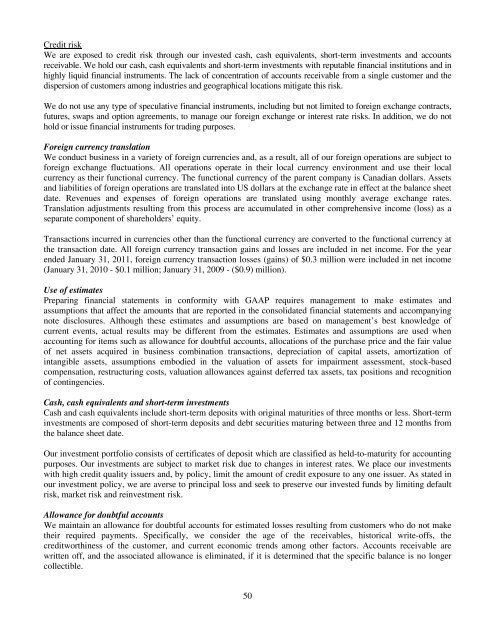THE DESCARTES SYSTEMS GROUP INC.
THE DESCARTES SYSTEMS GROUP INC.
THE DESCARTES SYSTEMS GROUP INC.
Create successful ePaper yourself
Turn your PDF publications into a flip-book with our unique Google optimized e-Paper software.
Credit risk<br />
We are exposed to credit risk through our invested cash, cash equivalents, short-term investments and accounts<br />
receivable. We hold our cash, cash equivalents and short-term investments with reputable financial institutions and in<br />
highly liquid financial instruments. The lack of concentration of accounts receivable from a single customer and the<br />
dispersion of customers among industries and geographical locations mitigate this risk.<br />
We do not use any type of speculative financial instruments, including but not limited to foreign exchange contracts,<br />
futures, swaps and option agreements, to manage our foreign exchange or interest rate risks. In addition, we do not<br />
hold or issue financial instruments for trading purposes.<br />
Foreign currency translation<br />
We conduct business in a variety of foreign currencies and, as a result, all of our foreign operations are subject to<br />
foreign exchange fluctuations. All operations operate in their local currency environment and use their local<br />
currency as their functional currency. The functional currency of the parent company is Canadian dollars. Assets<br />
and liabilities of foreign operations are translated into US dollars at the exchange rate in effect at the balance sheet<br />
date. Revenues and expenses of foreign operations are translated using monthly average exchange rates.<br />
Translation adjustments resulting from this process are accumulated in other comprehensive income (loss) as a<br />
separate component of shareholders’ equity.<br />
Transactions incurred in currencies other than the functional currency are converted to the functional currency at<br />
the transaction date. All foreign currency transaction gains and losses are included in net income. For the year<br />
ended January 31, 2011, foreign currency transaction losses (gains) of $0.3 million were included in net income<br />
(January 31, 2010 - $0.1 million; January 31, 2009 - ($0.9) million).<br />
Use of estimates<br />
Preparing financial statements in conformity with GAAP requires management to make estimates and<br />
assumptions that affect the amounts that are reported in the consolidated financial statements and accompanying<br />
note disclosures. Although these estimates and assumptions are based on management’s best knowledge of<br />
current events, actual results may be different from the estimates. Estimates and assumptions are used when<br />
accounting for items such as allowance for doubtful accounts, allocations of the purchase price and the fair value<br />
of net assets acquired in business combination transactions, depreciation of capital assets, amortization of<br />
intangible assets, assumptions embodied in the valuation of assets for impairment assessment, stock-based<br />
compensation, restructuring costs, valuation allowances against deferred tax assets, tax positions and recognition<br />
of contingencies.<br />
Cash, cash equivalents and short-term investments<br />
Cash and cash equivalents include short-term deposits with original maturities of three months or less. Short-term<br />
investments are composed of short-term deposits and debt securities maturing between three and 12 months from<br />
the balance sheet date.<br />
Our investment portfolio consists of certificates of deposit which are classified as held-to-maturity for accounting<br />
purposes. Our investments are subject to market risk due to changes in interest rates. We place our investments<br />
with high credit quality issuers and, by policy, limit the amount of credit exposure to any one issuer. As stated in<br />
our investment policy, we are averse to principal loss and seek to preserve our invested funds by limiting default<br />
risk, market risk and reinvestment risk.<br />
Allowance for doubtful accounts<br />
We maintain an allowance for doubtful accounts for estimated losses resulting from customers who do not make<br />
their required payments. Specifically, we consider the age of the receivables, historical write-offs, the<br />
creditworthiness of the customer, and current economic trends among other factors. Accounts receivable are<br />
written off, and the associated allowance is eliminated, if it is determined that the specific balance is no longer<br />
collectible.<br />
50



